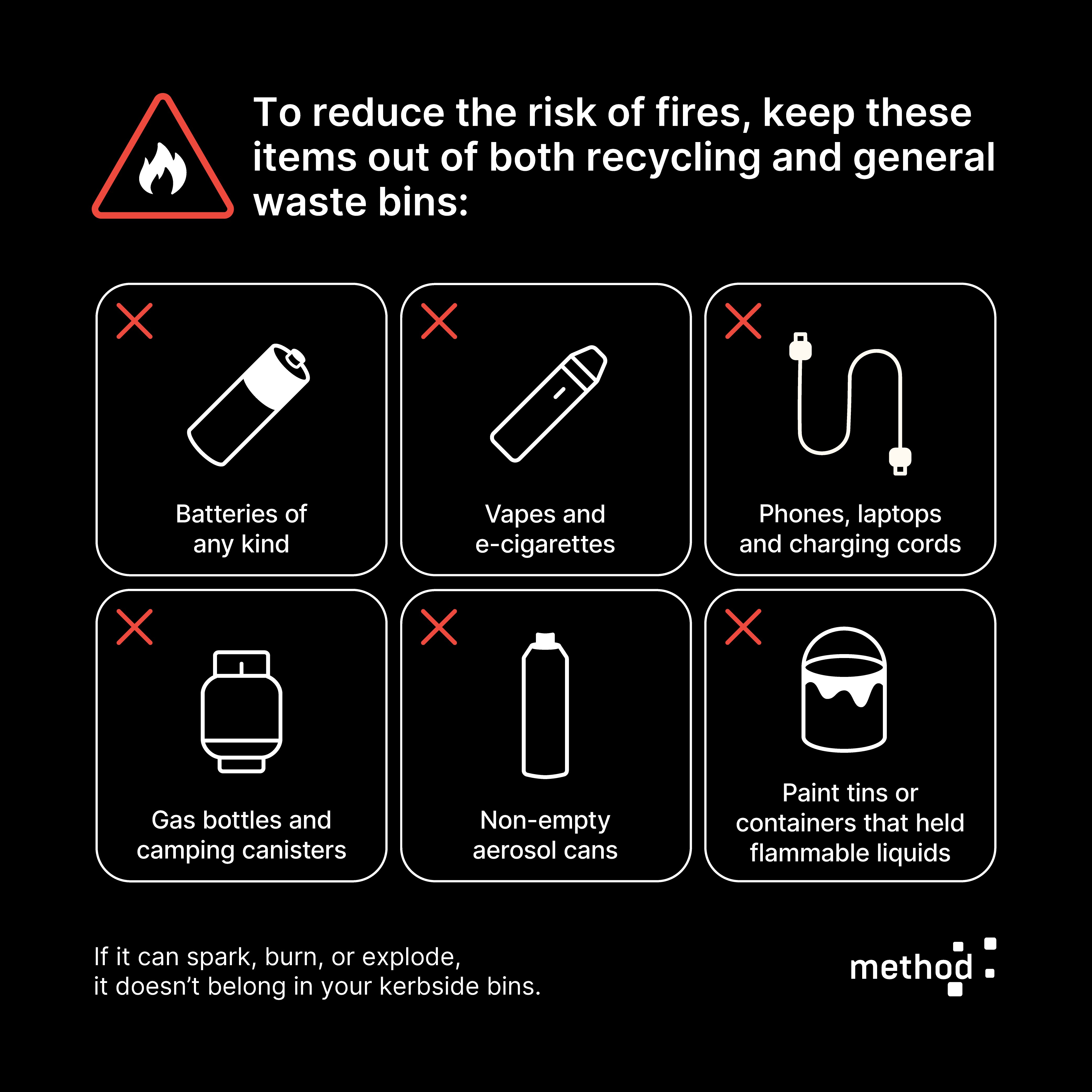do you want to view
Recycling 101: What’s Sparking Fires in Our Waste System?
You may have noticed that it’s becoming more common to see fires in recycling or landfill trucks, centres, and transfer stations. In 2024 on 9 News, Tony Khouury of the Waste Contractors and Recycling Association said there is a fire in a recycling truck or centre every day across Australia.
Many of these fires start with everyday items that were put in the wrong bin. The good news is that they’re preventable. And small changes in how we dispose of waste can make a big difference.
What's Causing These Fires?
Most fires come from items that don't belong in kerbside recycling or landfill bins. These are usually things that can ignite or explode when crushed or compacted.
Some common examples include:
- Batteries, especially lithium-ion (from vapes, phones, laptops, power tools)
- Electronics, cables and chargers
- Aerosol cans, particularly if not fully empty
- Gas bottles like BBQ or camping canisters
- Containers that held flammable liquids, such as paint thinners or solvents
When these items are put in general waste or recycling, they can cause sparks, heat, or pressure build-up that leads to fire.
Why It Matters
It goes without saying that fires are dangerous. But the fires cause more issues:
- Fires are becoming more frequent, particularly as our lives are more digitised
- They risk lives, especially for waste truck drivers and facility workers who often have little warning when something ignites.
- They disrupt the whole waste system—damaged trucks or machinery can mean entire loads go to landfill instead of being recycled - and great additional waste.
- They damage trust. When the public sees recycling centres burning, it undermines confidence in the system.
- They’re expensive. Repairing damage, halting operations, and managing emergencies cost councils and ratepayers money.
This isn’t just about safety. It’s about protecting the people and places behind the system. Waste management workers work hard to keep things moving smoothly, often behind the scenes. By preventing fires, we’re helping to keep them safe and ensuring our waste systems stay reliable and efficient for everyone.
What Not to Put in Your Bins
Here’s a quick list of things not to put in your bins to help keep waste and recycling safe:
- ❌ Batteries of any kind
- ❌ Vapes and e-cigarettes
- ❌ Phones, laptops, and charging cords
- ❌ Gas bottles or camping canisters
- ❌ Non-empty aerosol cans
- ❌ Paint tins or containers that held flammable liquids
If it can spark, burn, or explode, it doesn't belong in your general waste or recycling bin.
 Download and share with your team or on social media
Download and share with your team or on social media
What You Can Do Instead
Batteries, electronics, and cords:
Drop off phones, laptops, charging cords, and batteries at Officeworks, supermarkets, or your local council collection site. Cords may seem harmless, but they can jam recycling equipment and often get disposed of with electronics, making them part of the risk. Many councils also run e-waste events.
Batteries and electronics:
Drop them off at Officeworks, supermarkets, or your local council collection site. Many councils also run e-waste events.
Gas bottles and chemical containers:
Return gas bottles to a refill or swap point. For other flammable containers, use your local hazardous waste facility or council drop-off centre.
Aerosol Cans: Check Before You Dispose
Disposal rules for aerosols vary across Australia, so it’s important to know what applies in your area. Check your council website to confirm local guidelines.
Before you put aerosols in your recycling or landfill:
- Make sure they are completely empty - this includes deodorant, hairspray, cleaners and air fresheners
- If there’s still any pressure in the can or it makes a hissing noise, it is not safe to dispose of
- Leave the nozzle on unless your council says otherwise
Small Habits, Big Impact
Recycling and disposing of waste properly isn’t just good for the environment. It helps protect people and keeps systems running safely.
A single battery or half-full can might not seem like much, but it can shut down an entire truck or facility. When in doubt, check with your council. And if it’s hazardous or under pressure, leave it out.